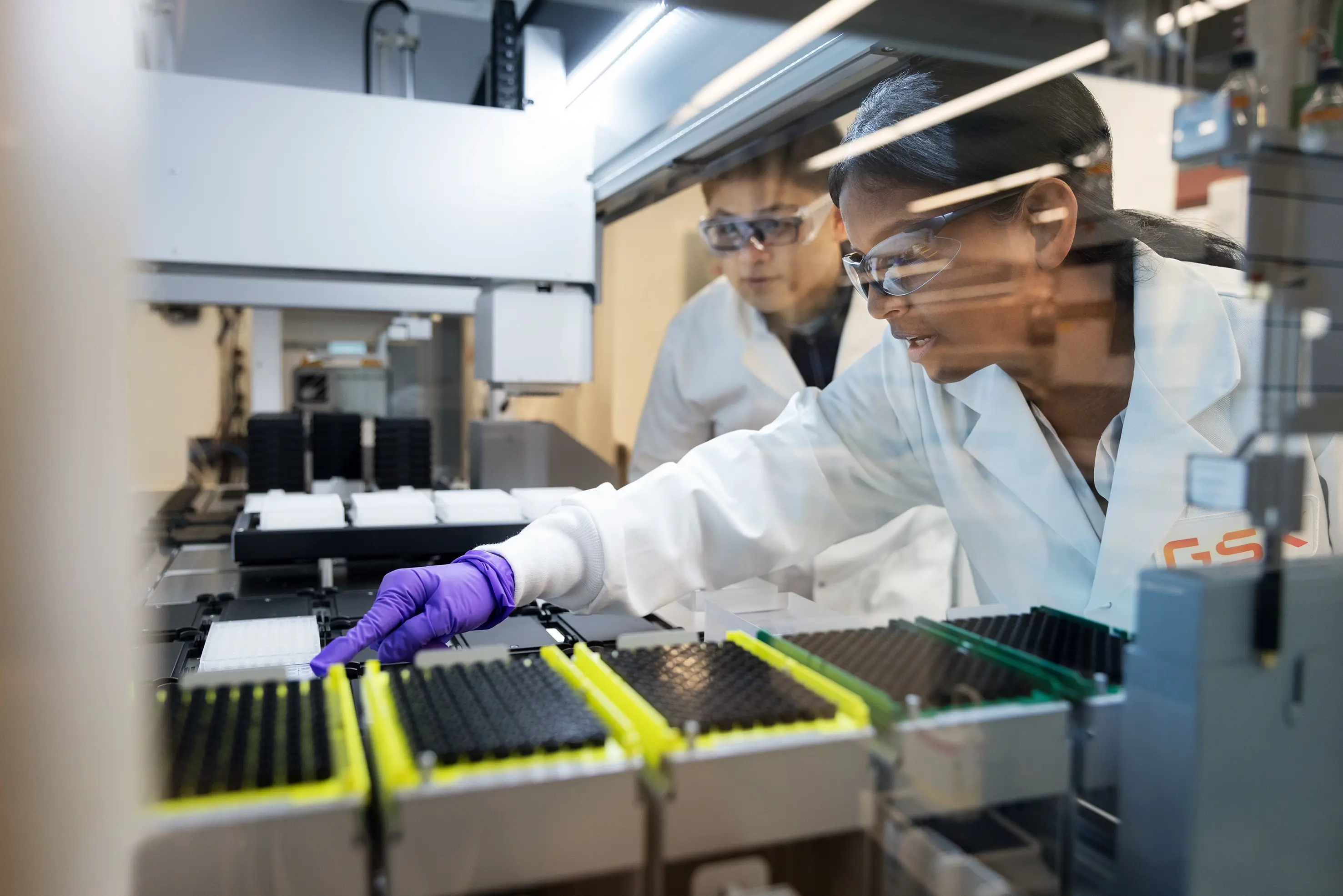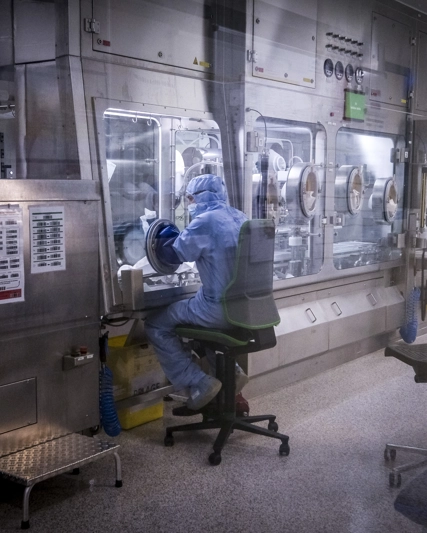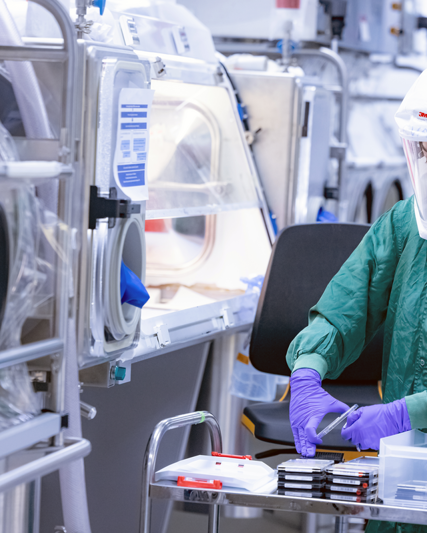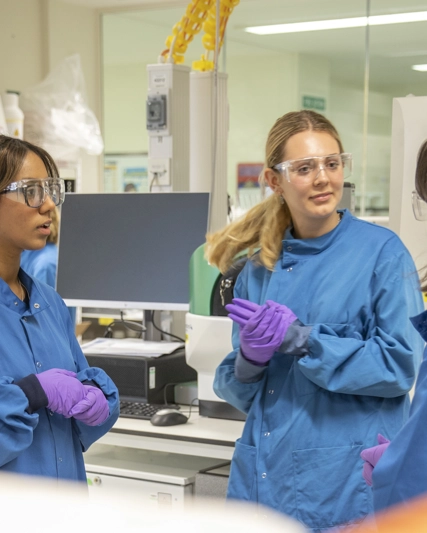The toughest challenge life scientists face is discovering new drugs that could eventually become effective medicines for patients. But modern technologies are helping to speed up the process – and find novel medicines and vaccines that could save lives.
Drugs and vaccines have the potential to change lives by preventing, slowing the progression, changing the course of, or curing disease. However, the road to creating new ones has traditionally been long and winding.
Drug discovery starts with finding a drug target. A target is typically a protein that is linked to a particular disease where a drug can have a therapeutic impact.
To identify this specific point of intervention, researchers use genomics, molecular biology, data analytics, and machine learning to uncover the underlying biology of disease and to locate a potential target. They then set to work discovering a drug candidate that will affect the chosen target in just the right way. This work is incredibly hard and time-consuming.
Further barriers to success occur during clinical trials, where 90% of drug candidates fail at some point during testing. When this happens, scientists are forced to start the process all over again.
Fortunately, cutting-edge technologies are helping researchers increase the odds of drug candidates becoming successful medicines.
“When it comes to discovering new drugs, we’re continuously working to identify and implement new technologies that increase the probability of success of new medicines and vaccines becoming available for patients,” says Dr. John Lepore, Senior Vice President and Head of Research at GSK.
GSK and its partners are now using an innovative range of approaches to do exactly that – including using genetic evidence to identify drug targets, targeting the genetic instructions for proteins (ribonucleic acid or “RNA”), and finding new diseases to apply to existing medicines.
Vice President of NCE Molecular Discovery, Dr. Christine Donahue, who leads some of these efforts at GSK, adds that while the strategies are diverse, the goal is always the same: to bring effective therapies to patients sooner.
“Patients are waiting,” says Donahue. “They're looking for us to accelerate our ability to get medicines to them. So we’re always asking ourselves how we can become even more effective in finding medicines for patients.”
Targets with human genetic evidence
More than 70% of GSK’s research and development (R&D) work begins with drug targets with genetic evidence, which improves the odds of producing a successful medicine.
“A paper published by GSK in 2015 first identified that drug targets with human genetic evidence linking a gene variant to risk for a disease have at least a twofold increase in becoming a successful medicine,” says Lepore.
“This realisation has helped us transform our approach to drug discovery, but has raised some new challenges,” says Erik Ingelsson, Senior Vice President of Genomic Sciences at GSK. “When we identify new drug targets using human genetics, many of them have no prior knowledge in the literature, so we need to do a lot of work to understand their function in disease and find the best approaches to modifying their function to help patients."
Using genetic information may point researchers towards better targets, but it doesn’t ensure they can make effective medicines for them. They then use functional genomics, the study of a person's genes and how those genes interact with each other and with the person's environment, which helps define the biology of the target in the context of the disease. Even then scientists may be left unable to develop drugs for every target.
This is because many of the targets discovered through genetics and genomics aren’t accessible to conventional small molecule or antibody drugs. In fact, up to 50% of genetically validated targets will require completely new types of drugs – and new technologies to discover them.
Fixing or destroying faulty instructions
Most genetics associated with disease do not impact the function of the protein target. Instead, they are thought to regulate the amount of the protein expressed, leading to too much or too little of these important proteins being made in the cell. To tackle this problem, GSK and its partners are employing several novel approaches to correct these expression defects.
One such approach is called therapeutic oligonucleotides – a promising method for genetically validated targets that can’t be modified through standard drug design.
Therapeutic oligonucleotides can help solve these issues because they target the RNA rather than the protein itself.
Therapeutic oligonucleotides are synthetic short chains of genetic material designed to target specific RNA sequences known to be involved in a disease. When a therapeutic oligonucleotide is administered, it binds to the target RNA and either prevents it from being translated into a protein or repairs the faulty sequence. What it doesn’t do is change the person’s DNA, it just changes how a gene is expressed. These mechanisms are often referred to as splicing, silencing, or editing.
GSK has two advanced clinical-stage oligonucleotide therapies in its pipeline, and a recent collaboration with Wave Life Sciences will expand its oligonucleotide work even further by adding another oligonucleotide therapeutic asset to its portfolio.
The collaboration also gives GSK access to Wave’s unique platform that enables three separate methods of modifying RNA: splicing, silencing, and editing. Through this discovery collaboration, Wave can advance up to three programmes with targets that have human genetic evidence identified by GSK, and GSK can advance up to eight genetically validated programmes using Wave’s proprietary discovery and development platform, PRISMTM.
“Oligonucleotides work by harnessing biological machinery that is already present in our cells and redeploying that machinery for therapeutic purposes,” says Paul Bolno, President and CEO of Wave Life Sciences.
“Wave has been building this unique oligonucleotide platform over the past 10 years, which can address disease biology by affecting RNA expression through multiple modalities.
“A great example of this is our RNA editing capability which offers multiple new approaches for modifying how proteins are expressed.
“Pairing GSK’s leadership in human genetics with the multitude of RNA-modifying tools available in our platform has enormous potential – both for the scientific field and for bringing life-changing medicines to patients and families.”
Other approaches to difficult drug biology
Beyond targeting RNA through oligonucleotide medicines, GSK is also exploring other mechanisms to modulate disease.
This includes GSK’s work in bi-specific antibodies. In areas like immunology, biology is complex and an effective medicine needs to correct multiple biological mechanisms. Bi-specific antibodies create a medicine that has two functional pieces, each targeting a different biological pathway.
Another method to combat the challenge is antibody drug conjugates (ADCs). They have an antibody that can specifically bind to disease cells and carry the medicine directly to the area of disease while also protecting healthy cells. This is important because this keeps those healthy cells safe, focusing directly – and only – on the area of disease.
Additionally, GSK is using a tool for drug discovery that capitalises on how cells naturally dispose of proteins. Using a strategy called targeted protein degradation, or PROTAC, researchers can design drugs that mimic this process, flagging and directing disease-causing proteins to the “disposal centre”. The method is useful for diseases that are caused by abnormal or excessive levels of proteins, including diseases like cancer.
“These are just a few of the approaches we are taking to transform how discovery is done,” Donahue concludes.
“GSK really focuses on developing and building out our toolbox, to give us a wide range of tools to address the challenge from multiple angles, including some still in early stages but showing enormous promise. The aim is to accelerate discovery and bring effective new medicines to patients sooner.”




